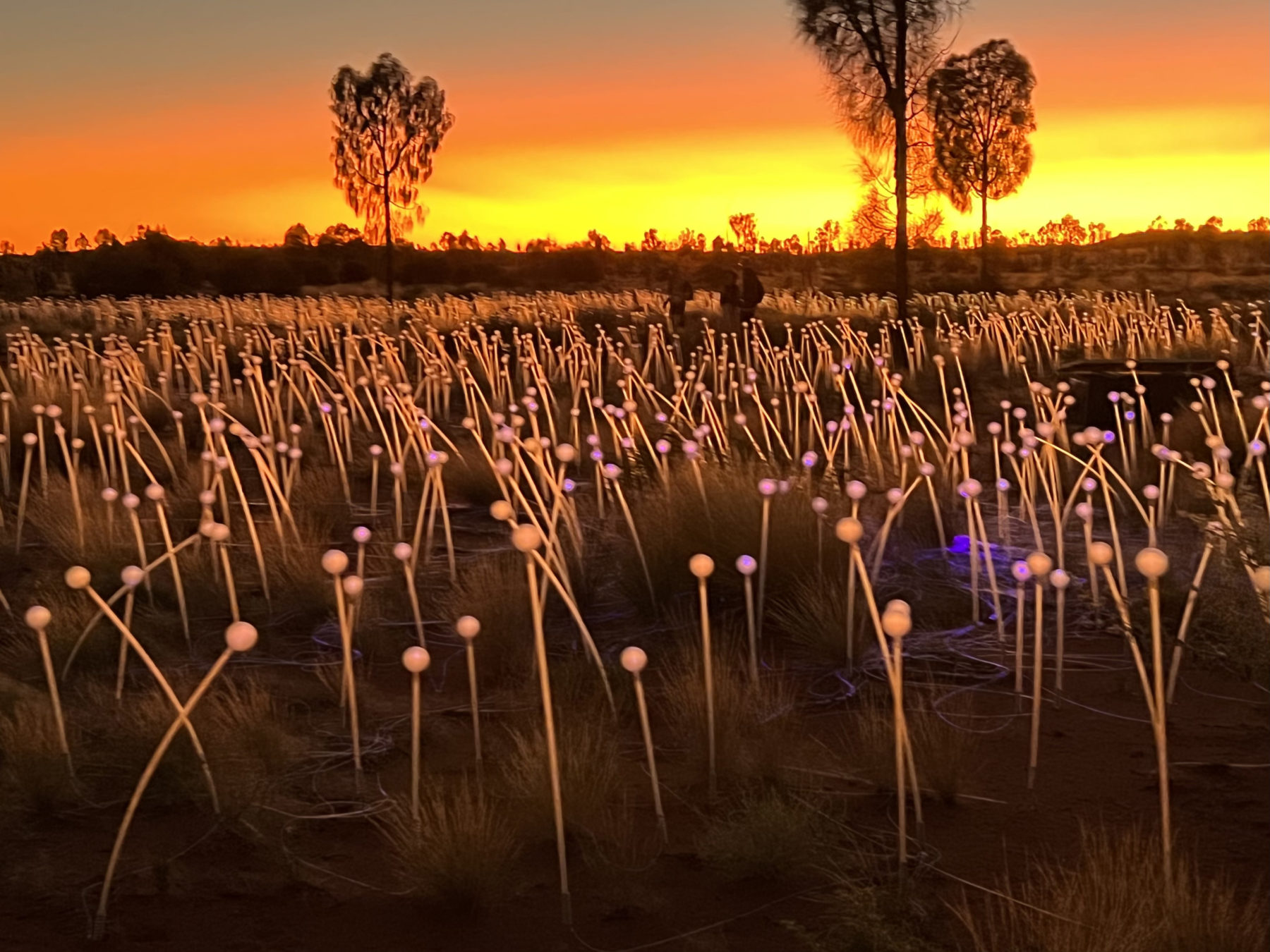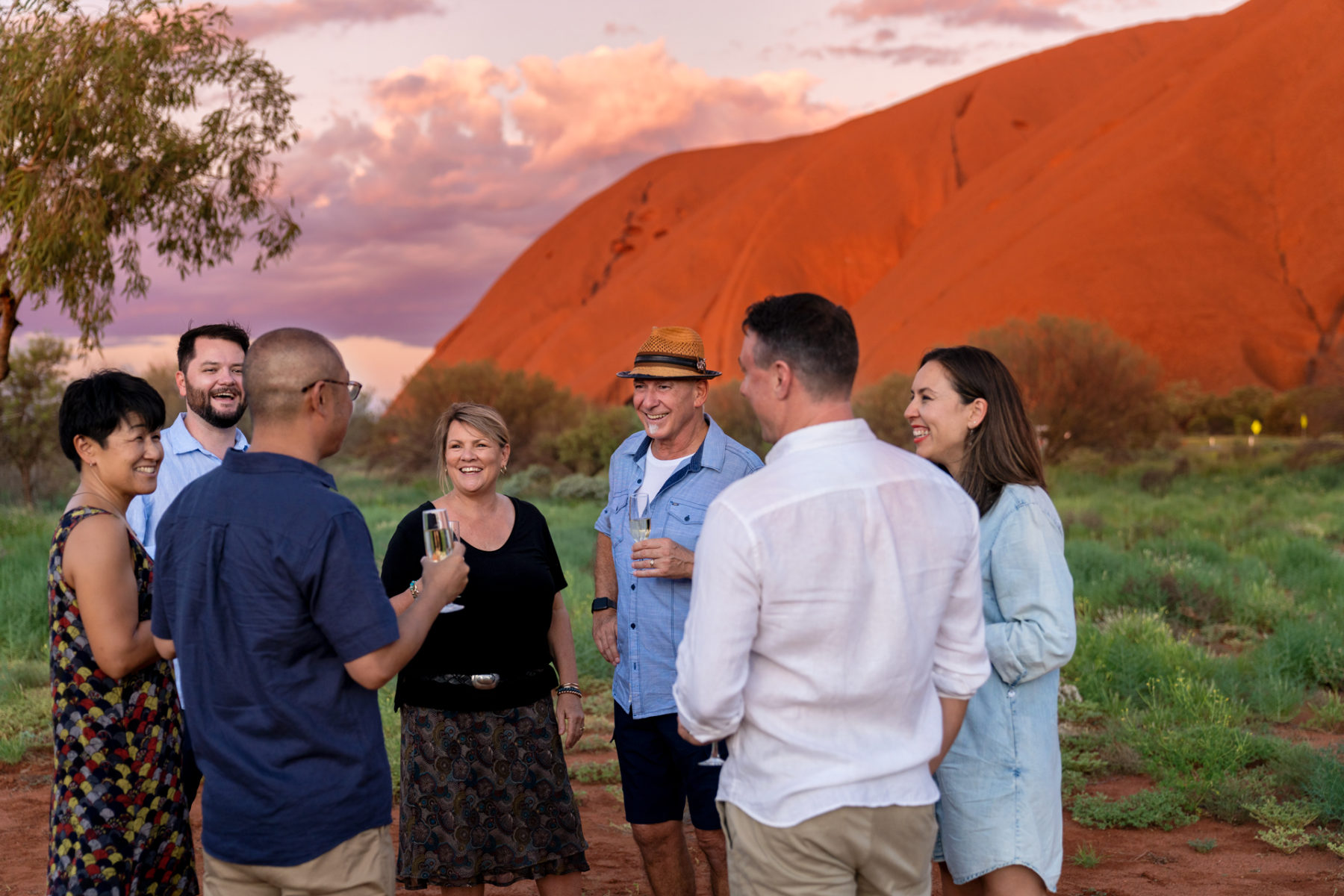Going beyond the icon

This article is brought to you by AAT Kings.
To see Uluru through Indigenous eyes is to be liberated from the old European idea of “Ayers Rock”.
No longer just a monolith to be captured in a photograph or – until recently – conquered by climbing, Uluru is transformed by the Indigenous perspective into a place of spiritual meaning and social connection.
It all begins with a voice. Our guide, Ken, an Anangu man in his late 20s from the local Mutitjulu community, speaks in a low, gravelly tone. English isn’t his first language – it’s his fifth, acquired after the dialects of the Western Desert that are more familiar to him. That very fact brings a jolt of foreignness to the experience of hearing him talk about this land. Words of Pitjantjatjara, one of the two main local dialects, pepper his speech and are translated for us by a second guide on this SEIT Outback Australia daytrip to Uluru.
Under a f lawless cerulean sky and against the backdrop of the mighty rock with its undulating striations, Ken tells the story of Kuniya the woma python, one of the ancestral beings of Uluru. It’s a passionate story of blood ties, grief, anger and revenge. As he speaks, Ken’s gestures dramatise the actions of the characters in the tale. His way of conveying the story is raw, urgent, personal – a world away from any textbook account.
Anangu believe that Kuniya has never left Uluru, a place which remains sacred and mysterious. To hear this story, told by a Traditional Owner steeped in its spirituality at the exact spot where it originated, is an unforgettable experience.
On another stop during our tour of the rock we see and hear about a different side of Uluru – the human, family side. At Kulpi Minymaku, the kitchen cave, we see where generations of Anangu women prepared food under an extraordinary wave-like rock overhang. And at Kulpi Nyiinkaku, the teaching cave, we hear how grandfathers taught teenage boys the tracking and hunting skills they would need for survival as men.
In this natural classroom the boys learnt about weaponry, topography and the hunt itself, the cave walls here functioning like blackboards. What look to us like painted decorations are in fact maps and diagrams representing features of the land such as waterholes; knowing their locations and how to find them was essential to the hunting process, because that is where animals would gather to drink. I’m surprised we’re allowed to photograph this rock art, but then I understand why. These aren’t sacred images, but instruction manuals for everyday life.
I love this insight into the ordinary lives of Anangu. Even though in their Tjukurpa (body of traditional knowledge) Anangu don’t separate “lore” from “law” (mythic Creation stories from knowledge of Country and rules for living), to my Western mind this cave-classroom speaks of a different realm of being from the supra-human story of Kuniya. This everyday realm of child-rearing and education is easy to imagine and relate to. Ken’s wife and beautiful baby daughter join us for this part of the tour, reinforcing a sense of Uluru not as a distant monument but as a magnet for family and community.
The same is true at the Mutitjulu Waterhole, one of the most visited points along the perimeter of Uluru.
Many people, including me, are amazed to learn that there’s a semi-permanent pool of water here. It’s a seemingly magical place that holds reflections of the rock in its tranquil surface. For Ken it also holds memories of coming here as a boy with his uncles and climbing the rock face with them. (“That was scary!” he says, laughing.) Did they swim here too? “Nah, we know better places,” he says – places that will not be revealed to us tourists.
When our tour comes to an end, I can’t believe how far I’ve travelled from my meagre preconception of Uluru as “a big rock”. I’ve experienced the Pitjantjatjara language, and been intrigued by the sound of English spoken as a foreign tongue by First Nations people. I’ve felt the power of story and witnessed the pull of memory, both anchored in this place and in the family and community relationships nurtured here. I understand now that Uluru is not just a sight to be seen, but the material embodiment of an ancient religion.
The journey has been far bigger than would seem possible in a half-day trip. It has been a crossing into a different way of life and a transformative way of seeing. I wouldn’t have missed it for the world.
TAKE A TOUR
ULURU ABORIGINAL ART AND CULTURAL EXPERIENCE
This day tour offers an Indigenous experience of Uluru with an emphasis on art.
A scenic drive around the base of Uluru opens the 4.5-hour tour. You’ll then meet your guide, a Traditional Owner from the Mutitjulu community, together with a member of the local Maruku Arts Gallery who acts as interpreter. Visiting the teaching and kitchen caves, you’ll hear stories from the Creation period as well as accounts of traditional Anangu life. The storytelling may be wholly or partly in Pitjantjatjara (translated as required) and is accompanied by symbolic sand-drawing, as it would have been in ancient desert society.
Adults from $265 plus park entry fee of $38. Park pass lasts three days and may be used multiple times. Children from $135.
Discover more here.

SUNRISE & FIELD OF LIGHT
It’s worth rising before the sun to see Field of Light at its most evocative, looking like an expanse of desert flowers waking up to the coming day. This AAT Kings day tour begins in darkness. See the lights spread out in a brilliant patchwork of colour and wander pathways through the installation. Tea, coffee and hot chocolate await on the dune- top when you return to see the sun rise over Uluru. Adults $75, Children $40.
Discover more here.

DINE IN THE SHADOW OF ULURU
Sample Indigenous-inspired cuisine at the Anangu-named Mai Uluru La Ila – “food close to Uluru” – the only outdoor dining experience offered inside Uluru-Kata Tjuta NP. Enjoy the sunset and drink in the view while you sip a locally inspired cocktail and munch on bush tucker canapés before the main course, a range of traditional barbecue favourites.
Adults from $219 plus park entry fee of $38. Park pass lasts three days and may be used multiple times. Children over nine years from $110.
Discover more here.


